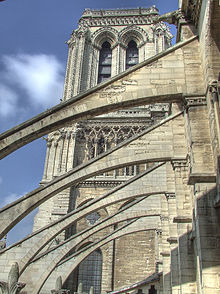Abutment (structural engineering)
Abutments in structural engineering support other components and, in addition to vertical loads, can also absorb a significant proportion of horizontal forces (e.g. arching ). This distinguishes them from bearings such as foundations and other foundations , which are predominantly designed only to accommodate vertical loads .
Abutments for arches are often referred to as fighters . Bridge abutments are usually solid masonry or concrete bodies that absorb horizontal compressive forces and divert them into the subsoil . Other components (e.g. buttresses and flying buttresses , apses , chapels or towers) can act as abutments.
For example, abutments are referred to as:
- Fighters of a vault (e.g. church building),
- Components for absorbing deflection forces in pipe bends,
- Support points for rafter roofs , provided they are integrated into the concrete ceiling.
- Abutment or abutment foundations of an arch in bridge construction. The anchor blocks for anchoring traction ropes from suspension bridges can also be viewed as abutments.
- Devices on which the jacking device is supported during horizontal pipe jacking (usually a press pit). Such abutments will only be created temporarily for the construction period.
- Anchoring blocks for the tensile forces of the prestressing steel for the factory production of prestressed concrete components in the prestressing bed .
- Components that absorb and divert the horizontal water pressure from the barricade structures in dam construction (dams, dam walls), also known as pulvino for arch dams .
Web links
Commons : Abutments - collection of images, videos and audio files
Individual evidence
- ↑ Building encyclopedia: abutment
- ↑ Wissen.de: Abutment ( Memento from November 23, 2011 in the Internet Archive )
- ↑ Wendehorst / Muth: Bautechnische number tables , 26th edition, BG Teubner Verlag Stuttgart, 1994.
- ^ Peter Rißler, Talsperrenpraxis , R. Oldenbourg Verlag Munich Vienna, 1998.

